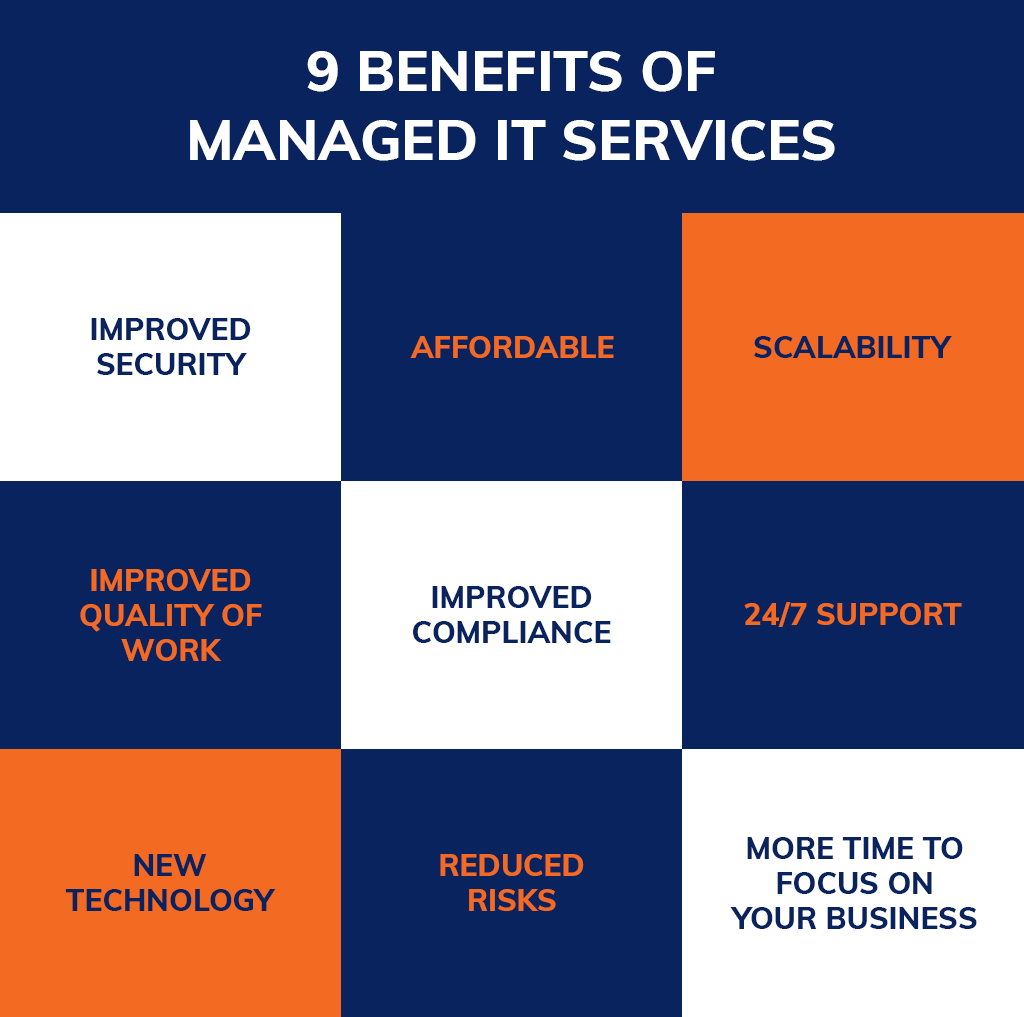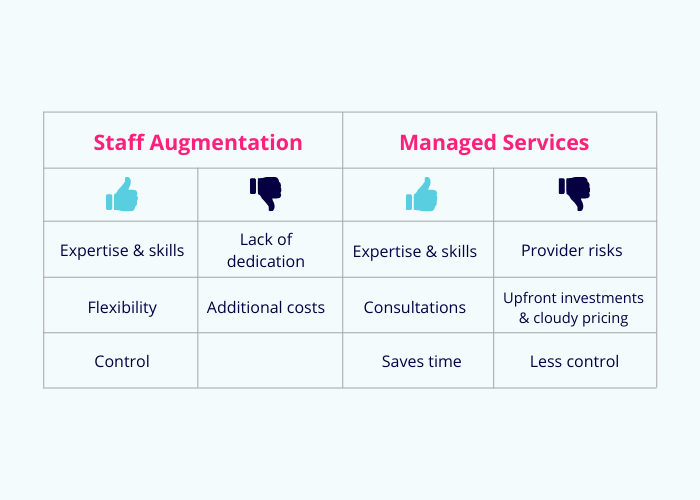On-demand staff augmentation is often used for IT project outsourcing. This model puts you in control and lets you decide what, how, and when to do it. You will need to have a leadership structure.
Managed Services are a much more restricted area. The service provider will handle the remainder, allowing you to concentrate on running your firm.
It is the responsibility of the provider to ensure that services meet industry standards.
This guide will explain the differences between IT Staff Augmentation vs. Managed Services. We’ll discuss all aspects that go into deciding which option is right for you.
IT Staff Augmentation vs. Managed Services: What Are They?

What is Staff Augmentation?
Staff augmentation refers to an outsourcing model where companies contract temporary outside staff to increase their existing team’s capacity. You have the option to tap into offshore, nearshore, and onshore talent, and scale up or down your team based on what you need.
Businesses can use staff augmentation in the IT industry for different stages of the development process. This includes programming, workflow optimization, and quality assurance. You can thus overcome roadblocks, hire key skills that your team might not have, meet time and budget constraints, fix bugs, and speed up product launches.
Staff augmentation may be cost-efficient and flexible for your business. This temporary solution allows you to use your existing staff and resources, while also allowing for outside talent and reducing operating expenses.
The Benefits of the Staff Augmentation Model
1. You can control and reduce risk with Staff Augmentation: This allows you to have complete control over the project’s outcome and monitor every aspect of the process. The project manager for the team will give tasks to prioritize work and guarantee a high-quality outcome.
You lose control of the custom Android app development process when you outsource it to third-party suppliers. However, with SA you can keep the entire team in-house and manage the project. This reduces the risk of substandard results.
2. Flexibility: This allows you to quickly acquire skills and capabilities that aren’t available and can compensate for staff shortages due to unanticipated events during project execution. You decide who and how long you want to employ.
3. Cost-effectiveness: You don’t have to hire permanent staff. However, increasing the number can help you save money on full-time wages. For the exact amount of time your team requires, you can get the assistance of highly-skilled experts.
4. This reduces recruitment time. In Staff Augmentation models the hiring process falls on the service provider. It is your job to decide with whom you would like to work together.
5. Flexibility: It depends on how large your project is, you might quickly find unique talents that are not readily available locally or at short notice. You can also scale up or down your team as necessary.
The Drawbacks of the Staff Augmentation Model
- Long-term relationships are key: Staff augmentation models may be challenged on long-term projects. Vendor workers might be asked to do additional work or leave the vendor.
- Staff augmentation can be costly: Long-term staff augmentation could end up costing you more than permanent in-house solutions. This is dependent on how simple it is to recruit and keep internal talent.
- Dependence: Staff augmentation can lead to greater dependence on one third-party provider.
- Engagement scale: It is possible to not source enough talent from one vendor. This can lead to inconsistencies in quality and require you to collaborate with multiple vendors and employees.
What are Managed Services?

Managed services refer to an outsourcing model where a company outsources certain functions to a third-party provider. This is known as a managed service provider (or MSP). Managed service providers can be contracted by businesses to handle virtually any task. This includes cybersecurity, data migration, database administration, and software development.
Managed service providers work independently, and are not part of the company’s IT staff. Managed service providers provide clients with a quote and a project timeline. Following that, they complete the job given to them while continuing their regular contact with the customer.
As it cuts down on overhead, HR work, resource management, and other costs, the managed services model can be cost-effective. Instead of overseeing work daily, the company can concentrate on other business tasks.
The Benefits of Managed IT Services

You can save time and money by using managed services. In both managed services model vs staff augmentation, prior allows you to hire a team of skilled and experienced professionals with the necessary technology and resources to complete your project. You can save time, money, and effort, and get the results you need. The cost of their services is set and fluctuates according to the volume of work completed.
- The Control: This is the person who oversees the entire project from beginning to end. It is important to choose a reputable and experienced company that has a track record of delivering superior results and high-quality products.
- Monitoring: The provider monitors all aspects of the project and makes sure that resources and tools are always available. The vendor determines the outcome of the project. The MS organization evaluates all risks and creates a plan to manage them.
- The improved cost model: Managed IT service providers’ prices according to outcomes. The cost will change following changes in your desire for a specific service. Service level agreements (SLA) are a guarantee of a managed IT service’s success. They define the scope and duration for each project. To get paid and increase the value of their work, managed service providers will do everything they can to keep promises.
- Access to talent: MSPs often have a larger staff augmentation firm than they do staff augmentation firms. As a result, they can provide a wider variety of abilities, information, and solutions to satisfy shifting client requirements.
Drawbacks to Managed IT Services Model
- Wrong service definition: Defining illogical services/touch-points means complexity will increase. Short-term outsourcing may be more costly than hiring additional staff.
- Over-specification: Service providers who provide too many details about how they should perform a service are less likely to be able to deliver the best service.
- Outsourcing the wrong processes: Processes that require high levels of knowledge and are unique for the client organization might not be suitable for managed services or outsourcing. Provider lock-in can occur when there is knowledge loss.
- Wrong retained company: Allowing specialists to manage your service provider will allow you to be “hands-on, eyes off” instead of the reverse.
IT Staff Augmentation vs. Managed Services: When to Use Each Model

What Makes IT Staff Augmentation Effective?
In certain cases, this outsourcing model will be the most effective. These are the most important reasons.
- You must improve your internal staff: Current expertise is required for some new projects. This is the reason your IT staff needs to be strengthened.
- There are no deadlines: It takes a while to complete the full hiring procedure, from posting jobs to onboarding. Regardless of the sort of contract, it is simple for mobile app developers for hire using the staff augmentation approach.
- Specific skills are required: You will need to quickly increase your team by hiring skilled engineers and technicians.
- As a bridge to hire: A short-term job may become a long-term relationship with an employee.
What is the Right Managed Services Model for you?
- If you’re focused on the future, security, and networking solutions become more complex as your company grows. Security and networking options that are quicker and more effective care provided by managed service companies.
- You can quickly adopt new technology by using managed service providers. They can provide client-centric solutions that are well-prepared technical.
- You must ensure compliance by your company. Compliance with regulations like HIPAA will be ensured by partnering with a managed services supplier.
- If you are looking to build a strong technical staff, there are several roles that your staff must fulfill. It may prove costly to fill these roles internally.
IT Staff Augmentation Vs. Comparison of Managed Services
You can consider staff augmentation or managed services when you are looking for dedicated developers. They are both different. Both involve outsourcing dedicated developers teams and serve different purposes. Below are the main differences between IT Staff Augmentation vs. Managed Services. Managed Services. Let’s take a look.
1. Pocket-Friendliness Vs. Specific Results
The most crucial difference between them is determined by the main company’s objectives. Based on their preference, businesses can choose from one of the two options.
Staff augmentation allows for a cost-effective staffing model that significantly lowers operational costs. This is the best choice for businesses that want to increase their business scope and remain cost-effective.
Managed Services should be considered if the company has particular needs. MSPs work with these businesses to accomplish specific goals. MSPs have complete control over the processes used to achieve desired results. Staff augmentation is cost-effective, while managed services are more effective in achieving desired results.
2. Accountability Vs. Flexible Hiring
Both IT outsourcing models offer distinct advantages and disadvantages. Staff augmentation allows the parent company to quickly conduct the hiring process, i.e. Staff augmentation allows the parent company to quickly conduct the hiring process, i.e. on-the-spot and still meet the project’s requirements. Model flexibility is demonstrated by the parent company’s ability to hire staffing solutions for short periods. MSPs place more importance on parent company accountability.
Before entering into any partnership, MSPs create a list with goals and objectives. MSPs are responsible for all promises and timely delivery. These two outsourcing models are designed to address different sets of needs. Staff augmentation is a flexible method of expert supplementation. Managed services, however, ensure accountability and are accountable for their parent companies.
3. Short-term Vs. Long-Term Relationship
Another difference is how long they have been associated with the parent company. The relationship between the service provider and the person seeking staff augmentation is temporary.
Most of the time, this relationship is transient and fleeting. The relationship enters hibernation when the parent company asks staff augmentation companies for assistance for the Android app developers for hire. The relationship is often resurrected when there is a new need.
MSPs on the other side have close relationships with their parent company. This trust is built on information sharing and mutual trust. MSPs are then dependent on parent companies for technical advice and information dissemination. The relationship between the MSP and the parent company is mutually beneficial and long-term for both parties. Staff augmentation is a short-term service, while managed services are long-lasting.
4. Project Scaling Vs. Operational Scaling
Both managed service and staff augmentation have their advantages and disadvantages when it comes to scaling. IT staff augmentation can provide substantial choices for project scaling due to the rising demand for skilled experts.
It is extremely helpful to add people to the existing workforce to meet the demands and scalability requirements. It does not offer any practical solutions for scaling operations and sharing knowledge.
Managed services can, however, provide complete consultation for scaling operations. It is much easier to add responsibilities to existing projects than it is to form a task force. Although flexible, it can be tedious if the latter is used constantly. The two models offer different scalability options that can be adapted to suit different needs.
5. Authority Vs. Discretion
Both models are equally weighted. However, the main difference between managed services and staff augmentation is the degree of autonomy and discretion that the project manager and executor has. The parent company is in a strong position for process management in the case of staff augmentation. The parent company has the final word on the matter of staff augmentation.
But managed services also refer to the transfer of discretionary power. MSP transfers project autonomy from the parent company to its MSP. The parent company is responsible for managing staff augmentation, while managed services are delegated to the MSP.
IT Staff Augmentation vs. Managed Services: Which Must You Choose?
Both IT Staff Augmentation vs. Managed Services is beneficial and risky. You need to evaluate the different aspects of your company to decide which model is best for you. You must take into account the following:
1. Flexibility
Both IT staff augmentation vs. managed services offers flexibility. Staff augmentation is best for those who have an in-house team that needs additional support or special skills. You can also scale your team according to your needs with this outsourcing model.
Managed services let you perform tasks and develop projects without the need for in-house staff. MSPs typically require you to pay an annual retainer and may not be able to scale up or down your team as needed.
2. Costs
Staff augmentation allows you to only pay for the time your supplemental staff works. This is a good option for both small and medium-sized companies with tight budgets, as well as large businesses.
Managed services providers, on the other hand, require a steady investment. Managed services providers bill on a retainer basis, often every year. This can be an excellent cost-saving solution if you don’t have an IT department. It is typically more costly than staff augmentation.
3. Control Level
According to experts, in staff augmentations vs. IT managed services, staff augmentation is more controllable. Staff augmentation allows you to add to your existing team and can participate actively in the project’s development.
You will communicate with your service management vendor frequently. Your daily activities and routines are less in your hands. This could lead to poor business decisions.
4. Security
Both outsourcing models require that you vet all employees. However, staff augmentation has fewer risks, which can be easily addressed with an NDA.
Managed services may require that you share sensitive information with third parties. To ensure you don’t end up paying for projects you don’t own, you must also address Intellectual Property rights when you contract a managed service provider.
5. Project Duration
Staff augmentation can be a cost-effective and efficient solution for short-term projects, low-budget projects, and other projects that need flexibility.
Managed services, on the other hand, are more suitable for long-term requirements and the outsourcing of whole projects because they can help reduce costs over a longer time.
Conclusion
Are you still unsure which outsourcing model is best? Which one is between IT Staff Augmentation Vs. managed Services? Managed Services
Managed IT services and staff augmentation are the two most popular methods for software development outsourcing. Each approach has unique benefits, drawbacks, and dangers.
If you need more control and responsibility, and the resources to manage a development group, in between staff augmentation and managed services, prior is the best option. If you prefer to outsource all the work to a development firm, managed services may be the best choice.
Now that you know what your business is, you can also see how each model operates. For business growth, choose the best staff augmentation or managed services company.
FAQ
What is the cost of IT staff augmentation Vs. managed services?
The cost for staff augmentation varies depending on the business needs. However, the cost for staff augmentation can be determined based on hourly rates paid by developers. This usually ranges between $25-$50 per hour. Depending on the developer’s abilities and experience, outsourced IT services will cost differently. These services can be provided on an hourly basis or as a project cost.
Why should you choose managed services?
Managed service providers (MSPs), are companies outside of the company that assists businesses with their IT requirements by providing support and maintenance. Modern businesses see managed IT services as a fast fix for changing needs.
Why do you need a staff augmentation?
Businesses often have limited resources which can lead to a longer turnaround time. Although permanent staff can get the job done it also increases costs (hiring and training), even when they’re not working on any particular project.
IT staff augmentation vs. managed services: How does it work in IT?
Businesses find it more efficient to use other engagement models than regular recruitment due to the growing demand for IT professionals around the world. There are many options available, such as team augmentation vs. managed IT services. Teams prefer to hire dedicated developers for remote rather than full-time employees. This enables them to rapidly identify the ideal personnel and close any gaps.
What is staff augmentation?
Expert IT specialists are brought in to augment staff. Contracting with a mobile app development company that provides on-demand access will give you the expertise you need.





























